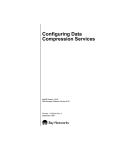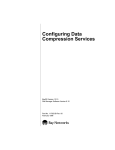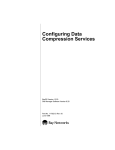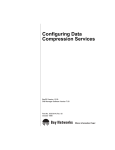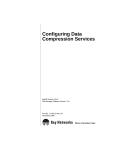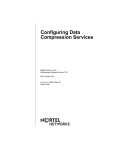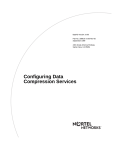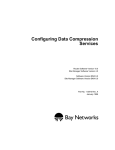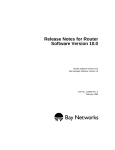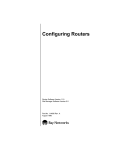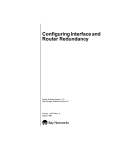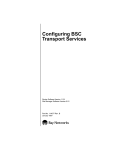Download Avaya Configuring Data Compression Services User's Manual
Transcript
Configuring Data Compression Services Router Software Version 11.0 Site Manager Software Version 5.0 Part No. 114061 Rev. A August 1996 4401 Great America Parkway Santa Clara, CA 95054 8 Federal Street Billerica, MA 01821 Copyright © 1988–1996 Bay Networks, Inc. All rights reserved. Printed in the USA. August 1996. The information in this document is subject to change without notice. The statements, configurations, technical data, and recommendations in this document are believed to be accurate and reliable, but are presented without express or implied warranty. Users must take full responsibility for their applications of any products specified in this document. The information in this document is proprietary to Bay Networks, Inc. The software described in this document is furnished under a license agreement and may only be used in accordance with the terms of that license. A summary of the Software License is included in this document. Restricted Rights Legend Use, duplication, or disclosure by the United States Government is subject to restrictions as set forth in subparagraph (c)(1)(ii) of the Rights in Technical Data and Computer Software clause at DFARS 252.227-7013. Notice for All Other Executive Agencies Notwithstanding any other license agreement that may pertain to, or accompany the delivery of, this computer software, the rights of the United States Government regarding its use, reproduction, and disclosure are as set forth in the Commercial Computer Software-Restricted Rights clause at FAR 52.227-19. Trademarks of Bay Networks, Inc. ACE, AFN, AN, BCN, BLN, BN, BNX, CN, FN, FRE, GAME, LN, Optivity, PPX, SynOptics, SynOptics Communications, Wellfleet and the Wellfleet logo are registered trademarks and ANH, ASN, Bay•SIS, BCNX, BLNX, EZ Install, EZ Internetwork, EZ LAN, PathMan, PhonePlus, Quick2Config, RouterMan, SPEX, Bay Networks, Bay Networks Press, the Bay Networks logo and the SynOptics logo are trademarks of Bay Networks, Inc. Third-Party Trademarks All other trademarks and registered trademarks are the property of their respective owners. Statement of Conditions In the interest of improving internal design, operational function, and/or reliability, Bay Networks, Inc. reserves the right to make changes to the products described in this document without notice. Bay Networks, Inc. does not assume any liability that may occur due to the use or application of the product(s) or circuit layout(s) described herein. Portions of the code in this software product are Copyright © 1988, Regents of the University of California. All rights reserved. Redistribution and use in source and binary forms of such portions are permitted, provided that the above copyright notice and this paragraph are duplicated in all such forms and that any documentation, advertising materials, and other materials related to such distribution and use acknowledge that such portions of the software were developed by the University of California, Berkeley. The name of the University may not be used to endorse or promote products derived from such portions of the software without specific prior written permission. SUCH PORTIONS OF THE SOFTWARE ARE PROVIDED “AS IS” AND WITHOUT ANY EXPRESS OR IMPLIED WARRANTIES, INCLUDING, WITHOUT LIMITATION, THE IMPLIED WARRANTIES OF MERCHANTABILITY AND FITNESS FOR A PARTICULAR PURPOSE. In addition, the program and information contained herein are licensed only pursuant to a license agreement that contains restrictions on use and disclosure (that may incorporate by reference certain limitations and notices imposed by third parties). ii 114061 Rev. A Bay Networks Software License Note: This is Bay Networks basic license document. In the absence of a software license agreement specifying varying terms, this license -- or the license included with the particular product -- shall govern licensee’s use of Bay Networks software. This Software License shall govern the licensing of all software provided to licensee by Bay Networks (“Software”). Bay Networks will provide licensee with Software in machine-readable form and related documentation (“Documentation”). The Software provided under this license is proprietary to Bay Networks and to third parties from whom Bay Networks has acquired license rights. Bay Networks will not grant any Software license whatsoever, either explicitly or implicitly, except by acceptance of an order for either Software or for a Bay Networks product (“Equipment”) that is packaged with Software. Each such license is subject to the following restrictions: 1. Upon delivery of the Software, Bay Networks grants to licensee a personal, nontransferable, nonexclusive license to use the Software with the Equipment with which or for which it was originally acquired, including use at any of licensee’s facilities to which the Equipment may be transferred, for the useful life of the Equipment unless earlier terminated by default or cancellation. Use of the Software shall be limited to such Equipment and to such facility. Software which is licensed for use on hardware not offered by Bay Networks is not subject to restricted use on any Equipment, however, unless otherwise specified on the Documentation, each licensed copy of such Software may only be installed on one hardware item at any time. 2. Licensee may use the Software with backup Equipment only if the Equipment with which or for which it was acquired is inoperative. 3. Licensee may make a single copy of the Software (but not firmware) for safekeeping (archives) or backup purposes. 4. Licensee may modify Software (but not firmware), or combine it with other software, subject to the provision that those portions of the resulting software which incorporate Software are subject to the restrictions of this license. Licensee shall not make the resulting software available for use by any third party. 5. Neither title nor ownership to Software passes to licensee. 6. Licensee shall not provide, or otherwise make available, any Software, in whole or in part, in any form, to any third party. Third parties do not include consultants, subcontractors, or agents of licensee who have licensee’s permission to use the Software at licensee’s facility, and who have agreed in writing to use the Software only in accordance with the restrictions of this license. 7. Third-party owners from whom Bay Networks has acquired license rights to software that is incorporated into Bay Networks products shall have the right to enforce the provisions of this license against licensee. 8. Licensee shall not remove or obscure any copyright, patent, trademark, trade secret, or similar intellectual property or restricted rights notice within or affixed to any Software and shall reproduce and affix such notice on any backup copy of Software or copies of software resulting from modification or combination performed by licensee as permitted by this license. 114061 Rev. A iii Bay Networks Software License (continued) 9. Licensee shall not reverse assemble, reverse compile, or in any way reverse engineer the Software. [Note: For licensees in the European Community, the Software Directive dated 14 May 1991 (as may be amended from time to time) shall apply for interoperability purposes. Licensee must notify Bay Networks in writing of any such intended examination of the Software and Bay Networks may provide review and assistance.] 10. Notwithstanding any foregoing terms to the contrary, if licensee licenses the Bay Networks product “Site Manager,” licensee may duplicate and install the Site Manager product as specified in the Documentation. This right is granted solely as necessary for use of Site Manager on hardware installed with licensee’s network. 11. This license will automatically terminate upon improper handling of Software, such as by disclosure, or Bay Networks may terminate this license by written notice to licensee if licensee fails to comply with any of the material provisions of this license and fails to cure such failure within thirty (30) days after the receipt of written notice from Bay Networks. Upon termination of this license, licensee shall discontinue all use of the Software and return the Software and Documentation, including all copies, to Bay Networks. 12. Licensee’s obligations under this license shall survive expiration or termination of this license. iv 114061 Rev. A Contents About This Guide Before You Begin .............................................................................................................xiii Conventions .....................................................................................................................xiv Acronyms ......................................................................................................................... xv Ordering Bay Networks Publications ............................................................................... xv Technical Support and Online Services Bay Networks Customer Service ................................................................................... xviii Bay Networks Information Services .................................................................................xix World Wide Web ........................................................................................................xix Customer Service FTP ..............................................................................................xix Support Source CD ................................................................................................... xx CompuServe ............................................................................................................. xx InfoFACTS .................................................................................................................xxi How to Get Help ........................................................................................................xxi Chapter 1 Starting Compression Preparing a Configuration File ........................................................................................1-1 Configuring Software Compression .........................................................................1-1 Configuring Hardware Compression ........................................................................1-2 Configuring Compression for the Backbone Node (BN) ....................................1-2 Configuring Compression for the Access Stack Node (ASN) ............................1-2 Starting Data Compression ............................................................................................1-3 Starting Data Compression for Frame Relay and PPP ............................................1-3 Starting Data Compression for X.25 ........................................................................1-3 Finding Further Information ............................................................................................1-3 Deleting Data Compression from a Platform ..................................................................1-4 114061 Rev. A v Chapter 2 Data Compression Overview Data Compression Architecture ......................................................................................2-2 LZ-77 Algorithm .......................................................................................................2-2 Compression Control Protocol (CCP) ......................................................................2-2 Bay Networks Compression (WCP) .........................................................................2-2 Data Compression Performance ....................................................................................2-3 Software Compression ...................................................................................................2-3 Hardware Compression ..................................................................................................2-3 Hardware Compression for the BN ..........................................................................2-4 Hardware Compression for the ASN ........................................................................2-4 Hardware Compression Contexts ............................................................................2-4 How Data Compression Works .......................................................................................2-5 CCP Negotiations .....................................................................................................2-7 WCP Negotiations ....................................................................................................2-7 Data Transmission ..........................................................................................................2-7 Compression Features for Specific Protocols .................................................................2-8 Frame Relay Services ..............................................................................................2-8 Frame Relay Hybrid Access ..............................................................................2-8 Frame Relay Dial Backup ..................................................................................2-8 Frame Relay Multiline ........................................................................................2-9 PPP Services ...........................................................................................................2-9 PPP Multiline .....................................................................................................2-9 PPP Multilink ...................................................................................................2-10 PPP Bandwidth-on-Demand ............................................................................2-10 PPP Dial-on-Demand ......................................................................................2-10 PPP Dial Backup .............................................................................................2-10 X.25 Services .........................................................................................................2-11 X.25 PDN and DDN Services ..........................................................................2-11 Adjusting X.25 Max Window Size ....................................................................2-11 Summary of Bay Networks Data Compression Features .............................................2-11 Software-Based Data Compression .......................................................................2-12 Hardware-Based Data Compression .....................................................................2-12 vi 114061 Rev. A Chapter 3 Customizing Data Compression Allocating Compression Memory ....................................................................................3-1 Maximizing Compression Ratio ................................................................................3-1 Maximizing Throughput ............................................................................................3-2 8 KB History Size ...............................................................................................3-2 32 KB History Size .............................................................................................3-2 History Size with Hardware Compression .........................................................3-3 Preventing Data Loss for Frame Relay and PPP .....................................................3-4 Configuring Hardware Compression ..............................................................................3-5 Selecting Software or Hardware Compression Engines ..........................................3-5 Selecting a Fallback Compression Mode .................................................................3-6 Appendix A Data Compression Parameters WCP Line Parameters ................................................................................................... A-1 WCP Circuit Interface Parameters ................................................................................. A-5 Index 114061 Rev. A vii Figures Figure 2-1. 114061 Rev. A CCP, WCP, and NCP Initialization on a PPP Link ....................................2-6 ix Tables Table 3-1. Table 3-2. 114061 Rev. A Hardware Compression -- 8 KB Contexts ................................................3-3 Hardware Compression -- 32 KB Contexts ..............................................3-4 xi About This Guide If you are responsible for configuring and managing Bay Networks™ routers and/or BNX® switching platforms running over Frame Relay, Point-to-Point, or X.25 networks, read this guide to learn how to customize Bay Networks platforms for software- and hardware-based data compression. Refer to this guide for • Instructions for starting compression (Chapter 1) • An overview of data compression services (Chapter 2) • Descriptions of and instructions for editing compression line and interface parameters (Chapter 3) • Default parameter settings (Appendix A) Before You Begin Before using this guide, you must complete the following procedures. For a new router: • Install the router (refer to the installation manual that came with your router). • Connect the router to the network and create a pilot configuration file (refer to Quick-Starting Routers, Connecting AN and ANH Systems to a Network, or Connecting ASN Routers to a Network). Make sure that you are running the latest version of Bay Networks Site Manager and router software. For instructions, refer to Upgrading Routers from Version 7–10.xx to Version 11.0. 114061 Rev. A xiii Configuring Data Compression Services Conventions bold text Indicates text that you need to enter, command names, and buttons in menu paths. Example: Enter wfsm & Example: Use the dinfo command. Example: ATM DXI > Interfaces > PVCs identifies the PVCs button in the window that appears when you select the Interfaces option from the ATM DXI menu. italic text Indicates variable values in command syntax descriptions, new terms, file and directory names, and book titles. quotation marks (“ ”) Indicate the title of a chapter or section within a book. screen text Indicates data that appears on the screen. Example: Set Bay Networks Trap Monitor Filters separator ( > ) Separates menu and option names in instructions and internal pin-to-pin wire connections. Example: Protocols > AppleTalk identifies the AppleTalk option in the Protocols menu. Example: Pin 7 > 19 > 20 vertical line (|) Indicates that you enter only one of the parts of the command. The vertical line separates choices. Do not type the vertical line when entering the command. Example: If the command syntax is show at routes | nets, you enter either show at routes or show at nets, but not both. xiv 114061 Rev. A About This Guide Acronyms CCP Compression Control Protocol CPC continuous packet compression CRC cyclic redundancy check DDN Defense Data Network IETF Internet Engineering Task Force ILI Intelligent Link Interface LCP Link Control Protocol MIB management information base NCP Network Control Protocol PDN Public Data Network PPC packet-by-packet compression PPP Point-to-Point Protocol PTOP Point-to-Point Protocol (proprietary to Bay Networks) PVC permanent virtual circuit RFC Request for Comment VC virtual circuit WAN wide area network WCP WAN Compression Protocol Ordering Bay Networks Publications To purchase additional copies of this document or other Bay Networks publications, order by part number from the Bay Networks Press™ at the following telephone or fax numbers: • Telephone - U.S./Canada • Telephone - International • Fax 1-888-4BAYPRESS 1-510-490-4752 1-510-498-2609 You can also use these numbers to request a free catalog of Bay Networks Press product publications. 114061 Rev. A xv Technical Support and Online Services To ensure comprehensive network support to our customers and partners worldwide, Bay Networks Customer Service has Technical Response Centers in key locations around the globe: • • • • • Billerica, Massachusetts Santa Clara, California Sydney, Australia Tokyo, Japan Valbonne, France The Technical Response Centers are connected via a redundant Frame Relay Network to a Common Problem Resolution system, enabling them to transmit and share information, and to provide live, around-the-clock support 365 days a year. Bay Networks Information Services complement the Bay Networks Service program portfolio by giving customers and partners access to the most current technical and support information through a choice of access/retrieval means. These include the World Wide Web, CompuServe, Support Source CD, Customer Support FTP, and InfoFACTS document fax service. 114061 Rev. A xvii Configuring Data Compression Services Bay Networks Customer Service If you purchased your Bay Networks product from a distributor or authorized reseller, contact that distributor’s or reseller’s technical support staff for assistance with installation, configuration, troubleshooting, or integration issues. Customers can also purchase direct support from Bay Networks through a variety of service programs. As part of our PhonePlus™ program, Bay Networks Service sets the industry standard, with 24-hour, 7-days-a-week telephone support available worldwide at no extra cost. Our complete range of contract and noncontract services also includes equipment staging and integration, installation support, on-site services, and replacement parts delivery -- within approximately 4 hours. To purchase any of the Bay Networks support programs, or if you have questions on program features, use the following numbers: Region Telephone Number Fax Number United States and Canada 1-800-2LANWAN; enter Express Routing Code (ERC) 290 when prompted (508) 670-8766 (508) 436-8880 (direct) Europe (33) 92-968-300 (33) 92-968-301 Asia/Pacific Region (612) 9927-8800 (612) 9927-8811 Latin America (407) 997-1713 (407) 997-1714 In addition, you can receive information on support programs from your local Bay Networks field sales office, or purchase Bay Networks support directly from your authorized partner. xviii 114061 Rev. A Technical Support and Online Services Bay Networks Information Services Bay Networks Information Services provide up-to-date support information as a first-line resource for network administration, expansion, and maintenance. This information is available from a variety of sources. World Wide Web The Bay Networks Customer Support Web Server offers a diverse library of technical documents, software agents, and other important technical information to Bay Networks customers and partners. A special benefit for contracted customers and resellers is the ability to access the Web Server to perform Case Management. This feature enables your support staff to interact directly with the network experts in our worldwide Technical Response Centers. A registered contact with a valid Site ID can • View a listing of support cases and determine the current status of any open case. Case history data includes severity designation, and telephone, e-mail, or other logs associated with the case. • Customize the listing of cases according to a variety of criteria, including date, severity, status, and case ID. • Log notes to existing open cases. • Create new cases for rapid, efficient handling of noncritical network situations. • Communicate directly via e-mail with the specific technical resources assigned to your case. The Bay Networks URL is http://www.baynetworks.com. Customer Service is a menu item on that home page. Customer Service FTP Accessible via URL ftp://support.baynetworks.com (134.177.3.26), this site combines and organizes support files and documentation from across the Bay Networks product suite, including switching products from our Centillion™ and Xylogics® business units. Central management and sponsorship of this FTP site lets you quickly locate information on any of your Bay Networks products. 114061 Rev. A xix Configuring Data Compression Services Support Source CD This CD-ROM -- sent quarterly to all contracted customers -- is a complete Bay Networks Service troubleshooting knowledge database with an intelligent text search engine. The Support Source CD contains extracts from our problem-tracking database; information from the Bay Networks Forum on CompuServe; comprehensive technical documentation, such as Customer Support Bulletins, Release Notes, software patches and fixes; and complete information on all Bay Networks Service programs. You can run a single version on Macintosh Windows 3.1, Windows 95, Windows NT, DOS, or UNIX computing platforms. A Web links feature enables you to go directly from the CD to various Bay Networks Web pages. CompuServe For assistance with noncritical network support issues, Bay Networks Information Services maintain an active forum on CompuServe, a global bulletin-board system. This forum provides file services, technology conferences, and a message section to get assistance from other users. The message section is monitored by Bay Networks engineers, who provide assistance wherever possible. Customers and resellers holding Bay Networks service contracts also have access to special libraries for advanced levels of support documentation and software. To take advantage of CompuServe’s recently enhanced menu options, the Bay Networks Forum has been re-engineered to allow links to our Web sites and FTP sites. We recommend the use of CompuServe Information Manager software to access these Bay Networks Information Services resources. To open an account and receive a local dial-up number in the United States, call CompuServe at 1-800-524-3388. Outside of the United States, call 1-614-529-1349, or your nearest CompuServe office. Ask for Representative No. 591. When you’re on line with your CompuServe account, you can reach us with the command GO BAYNET. xx 114061 Rev. A Technical Support and Online Services InfoFACTS InfoFACTS is the Bay Networks free 24-hour fax-on-demand service. This automated system has libraries of technical and product documents designed to help you manage and troubleshoot your Bay Networks products. The system responds to a fax from the caller or to a third party within minutes of being accessed. To use InfoFACTS in the United States or Canada, call toll-free 1-800-786-3228. Outside of North America, toll calls can be made to 1-408-764-1002. In Europe, toll-free numbers are also available for contacting both InfoFACTS and CompuServe. Please check our Web page for the listing in your country. How to Get Help Use the following numbers to reach your Bay Networks Technical Response Center: 114061 Rev. A Technical Response Center Telephone Number Fax Number Billerica, MA 1-800-2LANWAN (508) 670-8765 Santa Clara, CA 1-800-2LANWAN (408) 764-1188 Valbonne, France (33) 92-968-968 (33) 92-966-998 Sydney, Australia (612) 9927-8800 (612) 9927-8811 Tokyo, Japan (81) 3-5402-0180 (81) 3-5402-0173 xxi Chapter 1 Starting Compression The quickest way to begin using data compression on your network is to enable it with the default values that Bay Networks software supplies. The procedures in this chapter describe how. Preparing a Configuration File Before you can start data compression, you must: 1. Create and save a configuration file that has at least one WAN interface. 2. Retrieve the configuration file in local, remote, or dynamic mode. 3. Specify router hardware if this is a local mode configuration file. Configuring Software Compression Software compression works on all router platforms and all serial interfaces. You can use software compression with Frame Relay, PPP, or X.25. To configure software compression: 1. Select the link or net module connector on which you are enabling data compression. 2. Specify Frame Relay, PPP, or X.25 as the WAN protocol. Site Manager Path: From the Protocols window that appears after you select the link or net module, select PPP, Frame Relay, or X.25. Click on OK. The Select Protocols window appears. For further information about these steps, refer to Configuring Routers. 114061 Rev. A 1-1 Configuring Data Compression Services Configuring Hardware Compression To use hardware compression you must have an octal sync link module with a hardware compression daughterboard for the BN, or a hardware compression net module for the ASN. You can use hardware compression with Frame Relay and PPP. Configuring Compression for the Backbone Node (BN) To configure hardware compression for the BN®: 1. Select either AG2104037 or AG2104038. These are the octal sync link modules with hardware compression daughterboards. 2. Select a port. 3. Specify Frame Relay or PPP as the WAN protocol. Site Manager Path: From the Protocols window that appears after you select the port, select PPP or Frame Relay. Click on OK. The Select Protocols window appears. Configuring Compression for the Access Stack Node (ASN) To configure hardware compression for the ASN™: 1. Select either AG2104007 or AF2104012. These are the hardware compression net modules for the ASN. 2. Select a WAN connector on the same slot. 3. Select a port. 4. Specify Frame Relay or PPP as the WAN protocol. Site Manager Path: From the Protocols window that appears after you select the port, select PPP or Frame Relay. Click on OK. The Select Protocols window appears. 1-2 114061 Rev. A Starting Compression Note: If you have a hardware compression net module on an ASN, you can use hardware compression on any WAN port on that single router or slot. Hardware compression on the ASN does not work across slots; that is, it does not provide compression for any other ASNs in the stack. Starting Data Compression You enable data compression for PPP and Frame Relay differently from X.25. Starting Data Compression for Frame Relay and PPP Enable WCP. You can also enable other protocols that you want to configure. Site Manager Path: In the Select Protocols window, scroll down to select WCP. Click on OK. Starting Data Compression for X.25 You enable WCP only after you have added a service record. You can also enable other protocols at the same time. Site Manager Path: After you have configured a service record, in the Service Record Window, select Protocols > Add/Delete. The Select Protocols window appears. Scroll down to select WCP. Click on OK. You must also enable the X.25 service record compression parameter for each X.25 interface that you configure. See Configuring X.25 Services for further information about X.25 service records. Finding Further Information For detailed information on Bay Networks data compression, refer to Chapter 2. For information and recommendations about using nondefault values, refer to Chapter 3. 114061 Rev. A 1-3 Configuring Data Compression Services Deleting Data Compression from a Platform To delete WCP from all circuits on the router, complete the following steps. Site Manager Path: Configuration Manager > Protocols > WCP > Delete WCP. A window appears and prompts: Do you REALLY want to delete WCP? Click on OK. Site Manager returns you to the Configuration Manager window. WCP is no longer operating on the platform. 1-4 114061 Rev. A Chapter 2 Data Compression Overview Bay Networks data compression services enable you to reduce line costs and improve response times over wide area networks. Our data compression eliminates redundancies in data streams. When you use compression on your network, bandwidth efficiency improves, and you can transmit more data over a given amount of network bandwidth. Our compression services include • Software-based compression for Frame Relay, Point-to-Point Protocol (PPP), and X.25 networks for all router platforms and all serial interfaces. This includes PPP compression on multiline, multilink, on the ISDN BRI and PRI modules, and on interfaces that use raise DTR or V.25 bis signaling with dial services. It also includes Frame Relay compression on multiline and dial backup. • Hardware-based compression for Frame Relay and PPP networks that use the octal synchronous link module for the BN using Fast Routing Engine-2 (FRE®-2) processors. Hardware compression supports all of the PPP and Frame Relay services that software compression supports. • Hardware-based compression for Frame Relay and PPP networks for the ASN. A compression net module compresses data transmitted over a WAN network by dual and quad synchronous, MCE1/ISDN PRI, MCT1/ISDN, dual sync with ISDN BRI, and QBRI net modules. Hardware compression supports all of the PPP services that software compression supports. Bay Networks software- and hardware-based compression interoperate fully because they use the same algorithm. To use data compression effectively, you must decide how to allocate memory for this task. The goal is to compress data as much as possible and to transmit the data as quickly as possible without unduly taxing the resources of the router. 114061 Rev. A 2-1 Configuring Data Compression Services Data Compression Architecture Bay Networks uses the following algorithm and protocols to provide data compression services: • LZ-77 algorithm • Compression Control Protocol (draft RFC) • Bay Networks proprietary compression protocol (WCP) LZ-77 Algorithm We base our data compression on a Lempel-Ziv (LZ-77) algorithm. The algorithm uses a sliding history buffer that stores the data that the network link has processed most recently. The compressor compares new data strings with data it has already processed and stored in the buffer. When the compressor detects data strings that match data it has already processed, it replaces those strings with offset and length tokens that are shorter than the original strings, thus compressing the data. Compression Control Protocol (CCP) Bay Networks uses the draft RFC Compression Control Protocol (CCP) only to enable or disable compression for PPP. CCP also includes a history reset request and acknowledgment capability, but our implementation of data compression does not use these features. Bay Networks Compression (WCP) Bay Networks data compression uses WAN Compression Protocol (WCP), which is an IETF draft standard. WCP enables compression for Frame Relay and for X.25, and transports compressed packets for Frame Relay, X.25, and PPP. WCP negotiates compression mode, history size, and buffer size. For Frame Relay and PPP, WCP also retransmits packets in the event of packet loss, and protects against inadvertent data expansion (LAPB retransmits packets for X.25). 2-2 114061 Rev. A Data Compression Overview Data Compression Performance The goals in using data compression are to achieve a high compression ratio while maximizing throughput. Compression ratio is the size of uncompressed data compared to the size of the same data after it has been compressed. Throughput refers to the speed of transmitting data. The compression ratio varies according to the effectiveness of the compression algorithm, but also according to the characteristics of the data you are transmitting: data that includes a lot of redundant strings compresses at a high ratio. Throughput, or network response time, varies with the number of elements in the network that the data must traverse, including the compression/decompression process. Software Compression Bay Networks software-based data compression is most effective for sites that have WAN connections at relatively low speeds such as 56/64 KB, where you want to achieve data compression at low cost, and with minimal memory requirements. It supports up to 512 Kb/s on the FRE-040. For networks operating at faster speeds, you should use hardware compression. Hardware Compression Bay Networks hardware-based compression works with Frame Relay and PPP networks. It best serves sites that support T-1/E-1 lines, which often concentrate many lower-speed remote connections. Our hardware compression facility operates at high speeds, and also supports high-density WAN connections. Use hardware compression when you want to achieve high compression ratios and throughput, and also want to preserve router memory to perform other functions. We offer two compression daughterboards for the BN and two compression net modules for the ASN. 114061 Rev. A 2-3 Configuring Data Compression Services Hardware Compression for the BN The compression daughterboards for the BN are • AG2104037 - Octal Sync with a 32-contexts hardware compression daughterboard • AG2104038 - Octal Sync with a 128-contexts hardware compression daughterboard Hardware Compression for the ASN The hardware compression net modules for the ASN can compress data transmitted over WAN networks attached to dual and quad synchronous, MCE1/ISDN PRI, MCT1/ISDN, dual sync with ISDN BRI, and QBRI net modules. One compression net module in a single ASN can provide hardware compression for all the net modules on that router. It does not provide compression for any other ASNs in the stack. The compression net module is available in both a 32-contexts and a 128-contexts version. The compression net modules for the ASN are • AF2104007 - a 32-contexts hardware compression net module • AF2104012 - a 128-contexts hardware compression net module Hardware Compression Contexts A context refers to compression and decompression for a single virtual circuit (VC). Compression hardware maps a context to specific regions of compression and decompression memory. If you have a 32-contexts compression daughterboard or net module, you can simultaneously run compression over 31 continuous packet compression (CPC) contexts, each using an 8 KB history size, with one shared 8 KB packet-by-packet (PPC) context. If you have a 128-contexts compression daughterboard or net module, you can simultaneously run compression over 127 CPC contexts, each using an 8 KB history size, with one shared 8 KB PPC context. For more information on CPC and PPC, see the “Compression Mode” section later in this chapter. 2-4 114061 Rev. A Data Compression Overview The only difference between the 32-contexts and 128-contexts Bay Networks compression daughterboards and net modules is that the 128-contexts daughterboard and net module have more memory: 2 MB compression/1 MB decompression, as opposed to 512 KB compression/256 KB decompression for the 32-contexts daughterboard and net module. Note: You should plan your network to use hardware compression on the VCs most important to you within the limits of your equipment. If you configure more VCs for hardware compression than your daughterboard or net module can support, you have no way of controlling which VCs will in fact use hardware compression. By default, all VCs that exceed the hardware context limit use software compression. For more information, see the “History Size” section later in this chapter. How Data Compression Works The following sections describe how Bay Networks data compression works. As you read these sections, refer to Figure 2-1, which illustrates CCP and WCP initialization on a PPP link. 114061 Rev. A 2-5 Configuring Data Compression Services Router A Router B 1. PPP interface on network; LCP negotiations complete; begin CCP negotiations: Send Initialization-Request Send Initialization-Request Send Initialization-ACK Send Initialization-ACK 2. CCP negotiations complete; begin WCP negotiations, including compression mode, history size, and buffer size: Send Initialization-Request Send Initialization-Request Send Initialization-ACK Send Initialization-ACK 3. WCP negotiations complete; begin NCP negotiations: Send Configure-Request Send Configure-Request Send Configure-ACK Send Configure-ACK 4. NCP open; begin transmitting data: Send Data DC0001A Figure 2-1. 2-6 CCP, WCP, and NCP Initialization on a PPP Link 114061 Rev. A Data Compression Overview CCP Negotiations CCP allows the two ends of a PPP connection to negotiate whether to use data compression, and if so, which algorithm to use. Our implementation of compression uses only the LZ-77 algorithm. Note: If one side of a link requests an algorithm that the other side does not support, traffic over the link continues, but in uncompressed form. In the example shown in Figure 2-1, negotiations begin when PPP establishes a link. CCP uses the same configuration and network control protocol negotiations that the Link Control Protocol (LCP) uses. For a detailed explanation of LCP negotiations, see “Establishing the PPP Link” in Configuring PPP Services. WCP Negotiations Frame Relay and X.25 use WCP to negotiate whether to use data compression, and which algorithm to use. As with PPP, if one side of a link requests an algorithm that the other side does not support, traffic continues, but in uncompressed form. Each side of a link running data compression has a compressor, a decompressor, a compression history, and a retransmission buffer. When you configure compression, you can edit WCP parameters for compression mode, history size, and buffer size to optimize compression performance on your network. Data Transmission Frame Relay and X.25 data transmission using compression begins when WCP negotiations are complete. For PPP, Network Control Protocol (NCP) negotiations and WCP negotiations occur simultaneously. When PPP, NCP, and WCP negotiations are complete, data transmission using compression begins. 114061 Rev. A 2-7 Configuring Data Compression Services Compression Features for Specific Protocols Bay Networks data compression services vary in some details according to the WAN protocols that you configure. Read the following sections to learn about how our implementation of data compression applies to Frame Relay, PPP, and X.25 services. Frame Relay Services You can use software- or hardware-based data compression with Frame Relay. You can use compression with some VCs, and not with others, as you choose, both for regular Frame Relay VCs, and for those you configure in hybrid mode. You can also use compression with dial backup. You must enable compression on both sides of a Frame Relay link. If you enable data compression on only one side of the link, data transmission occurs, but in uncompressed form. Frame Relay Hybrid Access Hybrid access enables you to combine bridging and routing over a single Frame Relay interface. When you enable data compression for Frame Relay on a hybrid circuit, both the bridged and the routed traffic over that circuit are compressed. Note that compression applies only to the hybrid PVC, and not to the other PVCs from the main circuit, unless you have also enabled compression for those interfaces. Conversely, if you enable data compression for other PVCs, but not on a PVC you have configured for hybrid mode, the hybrid circuit does not use compression. Frame Relay Dial Backup Frame Relay enables you to configure a dial backup feature. If a primary Frame Relay circuit fails and you have enabled dial backup, the router automatically establishes a backup circuit. The backup circuit can be PPP or Frame Relay for a Frame Relay service record with only one PVC. The backup circuit is Frame Relay for a Frame Relay service record with two or more PVCs. 2-8 114061 Rev. A Data Compression Overview The backup circuit can inherit the primary’s configuration, or it can use its own. When the Frame Relay primary and backup use the same configuration, they have a shared configuration. The backup circuit uses the same network-layer address as the primary circuit. The data-link layer configuration, that is, the backup PVCs, DLCIs, and filters can be the same or different from the primary. If the backup uses a unique configuration, it is a secondary configuration. A secondary configuration uses a different network-layer address, PVCs, and filters from the primary. To use data compression with dial backup for Frame Relay, you must configure compression on the backup circuit, because with either a shared or secondary configuration, the backup PVCs can use different configurations from the primary. For further information on Bay Networks dial services, refer to Configuring Dial Services. Frame Relay Multiline Multiline is a feature that enables you to configure a single circuit that consists of one or more WAN data paths. A data path is a logical point-to-point channel; it can be a permanent or dial-up physical line, or it can be a virtual circuit connection. Multiline provides both increased fault tolerance and greater bandwidth between two sites. For more information about Bay Networks multiline, refer to Configuring Line Services. PPP Services You can use software or hardware data compression on all PPP circuits, including multiline and multilink, bandwidth-on-demand, dial-on-demand, and dial backup lines. When you use compression on a bandwidth-on-demand, dial-on-demand, or dial backup circuit, WCP automatically configures or deletes compression as lines are added to or removed from the circuit. PPP Multiline Multiline is a feature that enables you to configure a single circuit that consists of one or more WAN data paths. A data path is a logical point-to-point channel; it can be a permanent or dial-up physical line, or it can be a virtual circuit connection. Multiline provides both increased fault tolerance and greater bandwidth between two sites. 114061 Rev. A 2-9 Configuring Data Compression Services For more information about Bay Networks multiline, see Configuring Line Services. PPP Multilink The multilink feature of PPP provides capabilities beyond those of multiline circuits. Multilink consists of a bundle of lines between two peers, consisting of up to four links. Multilink can • • • • • Distribute traffic across the lines in the bundle in amounts roughly proportional to the effective bandwidth of each link. Use lines that have different speeds, proportionally distributing traffic over those lines. Balance traffic load and restore packet sequence. Use switched lines (such as ISDN-B channels) as well as leased lines. Monitor traffic volume. PPP Bandwidth-on-Demand Bandwidth-on-demand allows a secondary, dial-up line to augment a primary, leased line when the primary line experiences congestion. Congestion occurs when traffic volume exceeds line capacity. When congestion abates, the secondary line becomes inactive. PPP Dial-on-Demand Dial-on-demand enables you to establish a circuit only when you want to transmit and receive data, as opposed to having a leased line, which is always available. By using a circuit on a demand basis, you can significantly reduce your line costs. PPP Dial Backup PPP also allows you to configure a dial backup feature. If a primary PPP line fails and you have enabled dial backup, the router automatically establishes a backup line. You cannot enable any protocols, including compression, on a backup circuit, because a backup circuit inherits its protocols from the primary circuit. If the primary circuit uses compression, then the backup circuit does also. For further information on Bay Networks dial services, refer to Configuring Dial Services. 2-10 114061 Rev. A Data Compression Overview X.25 Services An X.25 network permits as many as 128 VCs to exist on the same physical link at the same time. You can configure each of those interfaces individually to use data compression or not. X.25 PDN and DDN Services When you use data compression on circuits that you configure for X.25 PDN or DDN services, you must be careful to enable compression on both sides of the link. If you configure compression on only one side of a PDN or DDN link, the data that travels over that link will be garbled. You must also remember to enable the X.25 service record compression parameter for each X.25 interface that you configure. See Configuring X.25 Services for more information about this parameter. Adjusting X.25 Max Window Size Window size can affect packet throughput across the X.25 network. Setting the X.25 Max Window Size parameter too low can cause the router to drop packets and render data compression ineffective. You should configure this parameter at a higher value than the default setting. Summary of Bay Networks Data Compression Features You can configure both software- and hardware-based compression • On a circuit or line basis • With multiline and multilink Features specific to software and hardware compression follow. 114061 Rev. A 2-11 Configuring Data Compression Services Software-Based Data Compression Software-based data compression works over WAN links running Frame Relay, PPP, or X.25. It includes • Compression for a FRE module at 4 x 128 KB/s compressed throughput, full duplex; or 512 KB/s aggregate compressed throughput • Compression on an Access Node (AN®) platform at 2 x 64 KB/s compressed throughput, full duplex; or 128 KB/s aggregate compressed throughput • Compression on all intelligent link interface modules (ILIs) that support serial and ISDN BRI ports • Support for all Bay Networks platforms: AN, ASN, and BN, plus VME • Compression on MCT-1 and MCE-1 lines Hardware-Based Data Compression Hardware compression works over WAN links running Frame Relay and PPP. Hardware compression is available as 2-12 • Optional daughterboards for Frame Relay and PPP networks that use the octal synchronous link module for the BN, using FRE-2 processors only. • Optional net modules for Frame Relay and PPP networks that use the ASN. Hardware compression can compress data transmitted over WANs attached to dual and quad synchronous, MCE1/ISDN PRI, MCT1/ISDN, dual sync with ISDN BRI, and QBRI net modules. 114061 Rev. A Chapter 3 Customizing Data Compression When you enable data compression, default values are in effect for all parameters (see parameter descriptions in Appendix A). You may want to change these values, depending on the requirements of your network. The following sections provide information about Bay Networks compression and decisions you make to use compression effectively on your network. Allocating Compression Memory Using compression on your network involves allocating memory to maximize compression without unduly taxing the resources of your system. You can select • A compression mode, to maximize compression ratio • A history size, to maximize throughput • A buffer size, to prevent data loss Maximizing Compression Ratio You can compress data in one of two modes: 114061 Rev. A • Continuous Packet Compression (CPC) maintains compression history across packets. CPC yields a higher compression ratio than does Packet-by-Packet. In most circumstances, you should select CPC, the default value, to maximize compression. • Packet-by-Packet Compression (PPC) creates a new history for each packet. PPC yields a lower compression ratio than does CPC. Select PPC only for links that drop a very large number of packets. Be aware that under these circumstances, implementing data compression may offer marginal or no advantages. 3-1 Configuring Data Compression Services If either side of the link specifies PPC, both sides of the link use PPC. Site Manager: Compression Mode parameter: page A-2 (line); page A-6 (circuit interface) Maximizing Throughput Each side of the link has both a compression and decompression history and a lookup table. The compression and decompression histories maintain a record of data that has already traveled across the network. The lookup tables maintain pointers to redundant strings and the offset and length tokens that replace each of those strings. You can specify either 8 KB or 32 KB of local memory to maintain a compression history. If the link uses software compression with a history of 8 KB, each end of the link allocates 8 KB of memory for compression, 16 KB for the compression lookup table, and 8 KB for decompression, or 32 KB. If the link uses a compression history of 32 KB, each end of the link allocates 32 KB of memory for compression, 64 KB for the compression lookup table, and 32 KB for decompression, for a total of 128 KB. Hardware compression entails similar requirements. If you select different values for history size for the two sides of the link, 8 KB becomes the history size for both sides of the link. 8 KB History Size In general, 8 KB histories are appropriate for Frame Relay and X.25, when you have large numbers of VCs and need to be conservative when you allocate memory to each of them. 32 KB History Size For PPP, with only one circuit per line, you may want to use a 32 KB history. You may want to allocate a 32 KB history size for links with speeds higher than 64 Kb/s to improve throughput. The compressor can find a data pattern match up to three times faster using a 32 KB history than an 8 KB history. 3-2 114061 Rev. A Customizing Data Compression History Size with Hardware Compression Hardware compression daughterboards and net modules are available in 32 and 128 contexts. The numbers 32 and 128 assume a history size of 8 KB per context, although you can configure history size at either 8 KB or 32 KB. For example, if you configure history size at 32 KB, you have used four 8 KB contexts, and you have that many fewer contexts available to run hardware compression on your network. Note: Although software compression does not put strict limits on the number of contexts you can configure, be aware that memory requirements for history size are the same for software and hardware compression. Both boards reserve one 8 KB context for PPC, as opposed to CPC. There is no limit to the number of VCs that can use this one PPC context. The maximum number of VCs for the compression engine is 256. The compression hardware uses memory in units called pages, where a page equals 32 KB of memory. Each context that uses a 32 KB history uses one page of memory. Restrictions for CPC contexts using either 8 or 32 KB histories are that the memory used for any one history must be continuous, and it may not cross pages. For 8 KB contexts, these restrictions create few constraints, but for 32 KB contexts, they are significant. Thirty-one CPC contexts each using an 8 KB history are possible on the 32 context board, and 127 contexts each using an 8 KB history are possible on the 128 context board. Table 3-1 indicates the maximum number of 8 KB contexts each board can support. Table 3-1. Hardware Compression -- 8 KB Contexts Max 8 KB CPC Contexts Available 32 KB Reserved 8 KB CPC Contexts PPC Context 32 Context Board 31 0 1 128 Context Board 127 0 1 On a 32 context board, the maximum number of 32 KB contexts is 7, and on a 128 context board, the maximum number of 32 KB contexts is 31, because of the 8 KB of memory the one PPC context requires. Table 3-2 summarizes this information. 114061 Rev. A 3-3 Configuring Data Compression Services Table 3-2. Hardware Compression -- 32 KB Contexts Max 32 KB CPC Contexts Available 8 KB CPC Contexts Reserved 8 KB PPC Context 32 Context Board 7 3 1 128 Context Board 31 3 1 You can mix 8 KB and 32 KB contexts on either board. Be aware that if you are bringing VCs up and down, memory may fragment. Even though you have 32 or more KB of compression memory available, if it is on different pages you will not be able to configure a 32 KB context. To solve this problem, you must save your configuration and reset the slot. When you reset the slot, available compression memory is rearranged to be contiguous. If you have memory available, you are always able to add an 8 KB context, because 8 KB is the smallest divisible amount of compression memory. Site Manager: History Size parameter: page A-3 (line); page A-7 (circuit interface) Preventing Data Loss for Frame Relay and PPP Buffer size is the amount of memory allocated to keep the transmission history. You must configure this parameter to protect against data loss if you run Frame Relay or PPP. You can use a buffer size of None, Normal, Large, or Very Large. The default value is Normal. Configure buffer space based on the following conditions: • Length of time it takes for data to travel over the link. A Normal buffer size usually suffices for a coast-to-coast connection within the United States. You may need a Large or Very Large buffer if your link is over a satellite connection. • Number of dropped packets. Increase the buffer size on a link with a large number of dropped packets. Decrease the buffer size, even to None, to conserve memory on a link with a very small number of dropped packets. 3-4 114061 Rev. A Customizing Data Compression • Number of resets. Increase the buffer size for a link with a large number of resets and a low number of dropped packets. Be aware, however, that a high number of resets may occur for reasons unrelated to buffer size. Note: X.25 is a reliable protocol, which means that it has features that check for errors and prevent data loss. Bay Networks data compression software therefore ignores the Buffer Size parameter for X.25, so if you are configuring compression for X.25, you do not need to set this parameter. Site Manager: Buffer Size parameter: page A-4 (line) Configuring Hardware Compression There are two issues specific to hardware compression. Selecting Software or Hardware Compression Engines When you configure a VC for compression, the default compression type varies. The default is software compression for link modules that do not support hardware compression; for those that do, the default is hardware (refer to “Hardware Compression” in Chapter 2). The default for a net module is software compression, unless the ASN has a hardware compression net module. If an ASN has a hardware compression net module, the default is hardware. You can use software compression even though you are using a hardware compression daughterboard or net module. Bay Networks recommends that you use hardware compression for connections greater than 512 Kb/s. You would also want to specify software compression for VCs in excess of the number of contexts your hardware compression daughterboard or net module can support. Configure a VC to use software compression by setting the Engine Type parameter to software. Site Manager: Engine Type parameter: page A-4 (line); page A-8 (circuit interface) 114061 Rev. A 3-5 Configuring Data Compression Services Selecting a Fallback Compression Mode Fallback compression mode is configurable on a line basis only. Use it to indicate the compression mode that you want to use when no hardware compression contexts are available. The options are Software CPC and Hardware PPC. Software CPC is a good choice for lower speed links, 64 Kb/s or less. It generally affords a better compression ratio than does Hardware PPC. Hardware PPC is a good choice for higher speed links, greater than 64 Kb/s. It provides better throughput than does Software CPC. Site Manager: Fallback Compression Mode parameter: page A-5 3-6 114061 Rev. A Appendix A Data Compression Parameters WCP Line Parameters Use the following descriptions to set Bay Networks data compression line parameters. Notice that the Site Manager path for all line parameters is the same, as is the path for all circuit interface parameters. This means that you can edit all line parameters or all interface parameters at the same time. Parameter: Enable Path: Default: Options: Function: Instructions: Configuration Manager > Protocols > WCP > Lines Enable Enable | Disable Enables or disables data compression on the line WCP automatically sets this parameter to Enable when you select WCP in the Select Protocols window. If you want to temporarily disable WCP rather than delete it from the platform, set this parameter to Disable. Reset it to Enable to reenable WCP. MIB Object ID: 1.3.6.1.4.1.18.3.4.22.1.1.2 114061 Rev. A A-1 Configuring Data Compression Services Parameter: Compression Mode Path: Default: Options: Function: Configuration Manager > Protocols > WCP > Lines Continuous Packet Continuous Packet | Packet by Packet Continuous Packet Compression (CPC) retains compression history across packets and allows a higher compression ratio than does Packet-by-Packet Compression (PPC). PPC resets compression history at the start of each packet, resulting in a lower compression ratio. Since PPC does not depend on previous packets, you should select this option for a link that drops a large number of packets. Instructions: Select either Continuous Packet or Packet by Packet. MIB Object ID: 1.3.6.1.4.1.18.3.4.22.1.1.5 A-2 114061 Rev. A Data Compression Parameters Parameter: History Size Path: Default: Options: Function: Configuration Manager > Protocols > WCP > Lines 32 K 32 K | 8 K Indicates the amount of memory allocated to compression history for the line. Remember that history size entails separate compression and decompression histories and lookup tables on each side of a link. For example, if the link uses software compression with a history of 8 KB, each end of the link allocates 8 KB of memory for compression, 16 KB for a compression lookup table, and 8 KB for decompression, or 32 KB total. If the link uses a compression history of 32 KB, each end of the link allocates 32 KB of memory for compression, 64 KB for a compression lookup table, and 32 KB for decompression, for a total of 128 KB. Hardware compression entails similar requirements. Selecting 32 K for PPP WCP should not pose a problem for the BN, because PPP allows only one circuit per line. Select 8 K or 32 K for Frame Relay and X.25 lines, depending on the resources of your network. Selecting 32 K for PPP WCP on the ASN can cause problems, particularly if you are using a 32-context compression net module. In general, 8 KB histories are appropriate for WAN links that run at 64 Kb/s or less, because less throughput is required. Use an 8 KB history size with Frame Relay and X.25, which have large numbers of VCs and low available bandwidth, and with PPP on a 32-context net module. You may want to allocate a 32 KB history size for links with speeds higher than 64 Kb/s to improve throughput. The compression engine can find a data pattern match up to three times faster using a 32 KB history than an 8 KB history. If you select different history sizes for the two sides of a link, the smaller of the two becomes the effective history size. Instructions: Select either 32 K or 8 K. MIB Object ID: 1.3.6.1.4.1.18.3.4.22.1.1.6 114061 Rev. A A-3 Configuring Data Compression Services Parameter: Buffer Size Path: Default: Options: Function: Configuration Manager > Protocols > WCP > Lines Normal Very Large | Large | Normal | None Indicates the amount of buffer memory for the transmission history on a line. Set this parameter according to the end-to-end round-trip length of a WCP connection. Instructions: Select Normal for most land-line, coast-to-coast connections. Select Large or Very Large for connections at a great distance from each other, such as satellite connections. Select None for links that drop a very small number of packets. Increase the buffer size for a link with a large number of resets. MIB Object ID: 1.3.6.1.4.1.18.3.4.22.1.1.7 Note: Because X.25 has features that check for errors and prevent data loss, Bay Networks data compression software ignores the Buffer Size parameter for X.25. If you are configuring compression for X.25, you do not have to set this parameter. Parameter: Engine Type Path: Configuration Manager > Protocols > WCP > Lines Default: Software, unless you have configured either an Octal Sync Link module that has a hardware compression daughterboard for the BN, or a hardware compression net module for the ASN, in which case the default is Hardware. Options: Software | Hardware Function: Determines whether compression for this node will be software- or hardware-based. You can use hardware compression with Frame Relay and PPP only. You can use software compression with Frame Relay, PPP, or X.25. Instructions: Select Software to use software-based compression or select Hardware to use hardware-based compression. MIB Object ID: 1.3.6.1.4.1.18.3.4.22.1.1.8 A-4 114061 Rev. A Data Compression Parameters Parameter: Fallback Compression Mode Path: Default: Options: Function: Configuration Manager > Protocols > WCP > Lines Software CPC Software CPC | Hardware PPC This parameter is for hardware compression only. Use it to indicate the compression mode you want to use when no hardware compression contexts are available. Software CPC is a good choice for lower speed links, 64 Kb/s or less. It generally affords a better compression ratio than does Hardware PPC. Hardware PPC is a good choice for higher speed links, greater than 64 Kb/s. It provides better throughput than does Software CPC. Refer to Chapter 1 for explanations of continuous packet and packet-by-packet compression modes. Instructions: Select Software CPC or Hardware PPC. MIB Object ID: 1.3.6.1.4.1.18.3.4.22.1.1.10 WCP Circuit Interface Parameters Use the following descriptions to set Bay Networks data compression. Parameter: Enable Path: Default: Options: Function: Instructions: Configuration Manager > Protocols > WCP > Interfaces Enable Enable | Disable Enables or disables data compression on the line WCP automatically sets this parameter to Enable when you select WCP in the Select Protocols window. If you want to temporarily disable WCP rather than delete it from the platform, set this parameter to Disable. Reset it to Enable to reenable WCP. MIB Object ID: 1.3.6.1.4.1.18.3.4.22.2.1.2 114061 Rev. A A-5 Configuring Data Compression Services Parameter: Compression Mode Path: Default: Options: Function: Configuration Manager > Protocols > WCP > Interfaces Inherit from Line Continuous Packet | Packet by Packet | Inherit from Line Indicates the compression mode on the circuit. Continuous Packet Compression (CPC) retains compression history across packets and allows a higher compression ratio than does Packet-by-Packet Compression (PPC). PPC resets compression history at the start of each packet, resulting in a lower compression ratio. Since PPC does not depend on previous packets, you should select this option for a link that drops a large number of packets. Inherit from Line allows you to set WCP parameters at the line level and apply them to circuits. For PPP, with only one circuit per line, this means that you can configure WCP at either the circuit level or the line level. Instructions: Select Inherit from Line if you want to accept the value in effect for the WCP Compression Mode line parameter. Otherwise, select either Continuous Packet or Packet by Packet. MIB Object ID: 1.3.6.1.4.1.18.3.4.22.2.1.4 A-6 114061 Rev. A Data Compression Parameters Parameter: History Size Path: Default: Options: Function: Configuration Manager > Protocols > WCP > Interfaces Inherit from Line 32 K | 8 K | Inherit from Line Indicates the amount of memory allocated to compression history for the circuit. Remember that history size entails separate compression and decompression histories and lookup tables on each side of a link. For example, if the link uses software compression with a history of 8 KB, each end of the link allocates 8 KB of memory for compression, 16 KB for a compression lookup table, and 8 KB for decompression, or 32 KB total. If the link uses a compression history of 32 KB, each end of the link allocates 32 KB of memory for compression, 64 KB for a compression lookup table, and 32 KB for decompression, for a total of 128 KB. Hardware compression entails similar requirements. Selecting 32 K for PPP WCP should not pose a problem for the BN, because PPP allows only one circuit per line. Select 8 K or 32 K for Frame Relay and X.25 lines, depending on the resources of your network. Selecting 32 K for PPP WCP on the ASN can cause problems, particularly if you are using a 32-context compression net module. In general, 8 KB histories are appropriate for WAN links that run at 64 Kb/s or less, because less throughput is required. Use an 8 KB history size with Frame Relay and X.25, which have large numbers of VCs and low available bandwidth, and with PPP on a 32-context net module. You may want to allocate a 32 KB history size for links with speeds higher than 64 Kb/s to improve throughput. The compression engine can find a data pattern match up to three times faster using a 32 KB history than an 8 KB history. If you select different history sizes for the two sides of a link, the smaller of the two becomes the effective history size. Inherit from Line allows you to set WCP parameters at the line level and apply them to circuits. Instructions: Select Inherit from Line if you want to accept the value in effect for the WCP History Size line parameter. Otherwise, select either 32 K or 8 K. MIB Object ID: 1.3.6.1.4.1.18.3.4.22.2.1.5 114061 Rev. A A-7 Configuring Data Compression Services Parameter: Engine Type Path: Default: Options: Function: Configuration Manager > Protocols > WCP > Interfaces Inherit from Line Software | Hardware | Inherit from Line Determines whether compression for this node will be software- or hardware-based. You can use hardware compression with Frame Relay and PPP only. You can use software compression with Frame Relay, PPP, or X.25. Instructions: Select Inherit from Line if you want to accept the value in effect for the WCP Engine Type line parameter. Otherwise, select Software to use software-based compression or select Hardware to use Hardware-based compression. MIB Object ID: 1.3.6.1.4.1.18.3.4.22.2.1.6 A-8 114061 Rev. A Index A allocating memory, 3-1 B bandwidth-on-demand, 2-9 Bay Networks CompuServe forum, xx Customer Service FTP, xix home page on World Wide Web, xix InfoFACTS service, xxi publications, ordering, xv support programs, xviii Support Source CD, xx Technical Response Center, xvii, xxi technical support, xvii buffer size, 3-4 C circuit interface parameters, A-5 to A-8 Compression Control Protocol (CCP) definition, 2-2 initialization, 2-6 negotiations, 2-7 compression modes, 3-1 compression ratio, 2-3 CompuServe, Bay Networks forum on, xx configuring hardware compression, 1-2 software compression, 1-1 Customer Service FTP, xix customer support. See getting help 114061 Rev. A D data compression architecture, 2-2 deleting from a router, 1-4 features, 2-12 modes continuous, 3-1 packet-by-packet, 3-1 overview, 2-1 to 2-12 performance, 2-3 starting, 1-1 to 1-3 daughterboards, for hardware compression, 2-4 deleting compression, 1-4 dial backup, 2-10 dial-on-demand, 2-9 E enabling data compression, 1-1 to 1-3 F fallback compression mode, 3-6 Frame Relay data compression features, 2-8 modes, 2-8 G getting help from a Bay Networks Technical Response Center, xxi from the Support Source CD, xx through CompuServe, xx Index-1 Configuring Data Compression Services getting help (continued) through Customer Service FTP, xix through InfoFACTS service, xxi through World Wide Web, xix PPP (continued) dial-on-demand, 2-9 multiline, 2-9 multilink, 2-9 H S hardware compression, 2-12 configuring, 1-2 daughterboards, 2-3 history buffer, 2-2 history size, 3-2 software compression, 2-3 configuring, 1-1 starting data compression, 1-1 to 1-3 Support Source CD, xx I T throughput, 2-3, 3-2 InfoFACTS service, xxi L W Max Window Size parameter (X.25), 2-11 multiline, 2-9 multilink, 2-10 WCP definition, 2-2 deleting from a router, 1-4 features, 2-12 initialization, 2-6 negotiations, 2-7 overview, 2-1 to 2-12 World Wide Web, Bay Networks home page on, xix N X Network Control Protocol (NCP) negotiations, 2-6, 2-7 X.25 data compression features, 2-11 DDN service, 2-11 Max Window Size parameter, 2-11 PDN service, 2-11 Lempel-Ziv (LZ-77) algorithm, 2-2 line parameters, A-1 to A-5 M P parameters circuit interface, A-5 to A-8 line, A-1 to A-5 performance, 2-3 PPP bandwidth-on-demand, 2-9 data compression features, 2-9 dial backup, 2-10 Index-2 114061 Rev. A






















































